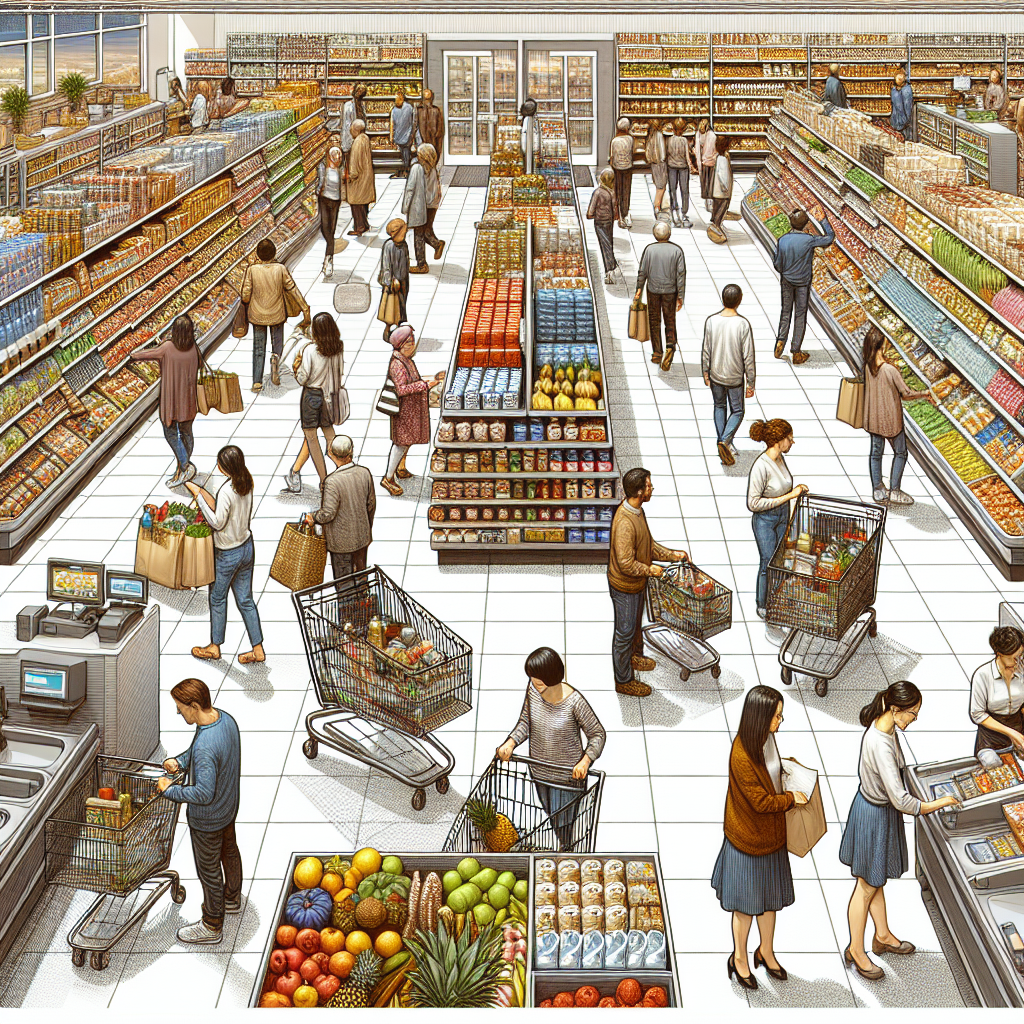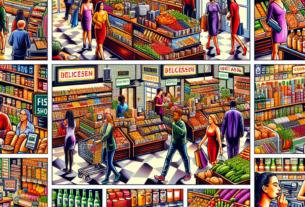The State of the Global Grocery Retail Industry in 2025: Trends, Challenges, and Opportunities
The grocery retail industry has undergone significant transformations over the past decade, driven by changing consumer preferences, advancements in technology, and evolving business models. In this report, we will explore the various grocery retail business models, from hypermarkets to convenience stores, and analyze the current state of the global grocery retail industry in 2025. We will also discuss the key trends, challenges, and opportunities facing grocery retailers in the coming years.
Overview of the Grocery Retail Industry
The grocery retail industry is a crucial component of the global economy, providing essential goods and services to consumers around the world. According to a report by CulinaryCoverage.com, the global grocery retail market was valued at $8.5 trillion in 2024 and is projected to reach $10.4 trillion by 2030, growing at a CAGR of 3.5% during the forecast period. The industry is highly fragmented, with a large number of players operating across different segments, including hypermarkets, supermarkets, convenience stores, and online grocery platforms.
Hypermarkets
Hypermarkets are large retail stores that combine a supermarket and a department store, offering a wide range of products, including groceries, household items, apparel, electronics, and more. Hypermarkets are known for their extensive product assortment, competitive pricing, and one-stop shopping experience. Some of the key players in the hypermarket segment include Walmart, Carrefour, Tesco, and Costco.
In 2025, hypermarkets continue to dominate the grocery retail landscape, accounting for approximately 40% of total grocery sales globally. However, hypermarkets are facing increasing competition from online grocery platforms and convenience stores, which offer greater convenience and flexibility to consumers. To stay competitive, hypermarkets are investing in digital transformation, omnichannel integration, and store format innovation to enhance the shopping experience and drive customer loyalty.
Supermarkets
Supermarkets are smaller grocery stores that focus primarily on food and household essentials, catering to the daily needs of consumers. Supermarkets typically carry a wide assortment of fresh produce, packaged goods, dairy products, and frozen foods, as well as non-food items like cleaning supplies and personal care products. Some of the leading supermarket chains include Kroger, Ahold Delhaize, Lidl, and Aldi.
In 2025, supermarkets continue to play a significant role in the grocery retail industry, accounting for approximately 30% of total grocery sales globally. Supermarkets are known for their convenient locations, competitive pricing, and personalized customer service. To adapt to changing consumer preferences and market dynamics, supermarkets are focusing on expanding their private label offerings, implementing sustainability initiatives, and enhancing their online and mobile capabilities to attract and retain customers.
Convenience Stores
Convenience stores are small retail outlets that offer a limited selection of products, primarily focusing on convenience and quick service. Convenience stores typically carry a mix of snacks, beverages, tobacco products, and basic household items, catering to consumers on the go. Some of the major convenience store chains include 7-Eleven, FamilyMart, Lawson, and Circle K.
In 2025, convenience stores are experiencing rapid growth and gaining market share in the grocery retail industry, driven by changing consumer lifestyles, urbanization, and increasing demand for convenience. Convenience stores are expanding their product offerings, introducing new formats like grab-and-go meal solutions and expanding their digital capabilities to enhance the shopping experience. Convenience stores are also leveraging data analytics and artificial intelligence to optimize inventory management, pricing strategies, and customer engagement.
Key Trends in the Grocery Retail Industry
The grocery retail industry is witnessing several key trends that are reshaping the competitive landscape and driving innovation across different business models. Some of the key trends include:
1. Digital Transformation
Digital transformation is revolutionizing the grocery retail industry, enabling retailers to leverage data, analytics, and technology to enhance the customer experience, optimize operations, and drive growth. Retailers are investing in e-commerce platforms, mobile apps, and digital marketing to reach consumers online and offer a seamless shopping experience across channels. Digital transformation is also enabling retailers to personalize promotions, recommendations, and loyalty programs based on customer preferences and behavior.
2. Omnichannel Integration
Omnichannel integration is becoming increasingly important for grocery retailers to provide a cohesive and consistent shopping experience across physical and digital channels. Retailers are integrating their online and offline operations, enabling customers to shop seamlessly across channels, access product information, compare prices, and choose from multiple fulfillment options like in-store pickup, home delivery, and curbside pickup. Omnichannel integration is also enabling retailers to capture and analyze customer data to drive personalized marketing and enhance customer engagement.
3. Sustainability Initiatives
Sustainability is a growing priority for grocery retailers, driven by increasing consumer awareness of environmental issues, ethical sourcing practices, and social responsibility. Retailers are implementing sustainability initiatives across their supply chain, packaging, waste management, and energy efficiency to reduce their carbon footprint, minimize food waste, and support local communities. Retailers are also offering sustainable products, organic options, and eco-friendly packaging to meet the evolving preferences of environmentally conscious consumers.
4. Personalization and Customization
Personalization and customization are key strategies for grocery retailers to differentiate their offerings, build customer loyalty, and drive repeat purchases. Retailers are leveraging data analytics, artificial intelligence, and machine learning to analyze customer behavior, preferences, and purchase history to deliver personalized recommendations, promotions, and offers. Retailers are also introducing custom meal kits, personalized nutrition plans, and tailored product assortments to meet the unique needs and preferences of individual customers.
Challenges Facing the Grocery Retail Industry
Despite the opportunities for growth and innovation, the grocery retail industry faces several challenges that are impacting the profitability, competitiveness, and sustainability of retailers. Some of the key challenges include:
1. Intense Competition
The grocery retail industry is highly competitive, with a large number of players vying for market share and consumer spending. Retailers face intense competition from traditional competitors, online platforms, discounters, and new entrants, leading to price wars, margin pressure, and market saturation. Retailers must differentiate their offerings, enhance customer experience, and innovate to stay ahead of the competition and retain market share.
2. Margin Pressures
Grocery retailers are facing margin pressures due to rising operating costs, price competition, and changing consumer behavior. Retailers must manage costs, optimize pricing strategies, and improve operational efficiency to maintain profitability and sustain growth. Retailers are also facing pressure from suppliers, manufacturers, and distributors to lower prices, negotiate favorable terms, and manage inventory effectively to minimize waste and maximize profitability.
3. Supply Chain Disruptions
The grocery retail industry is vulnerable to supply chain disruptions, including natural disasters, geopolitical events, trade disputes, and pandemics, which can impact the availability, pricing, and quality of products. Retailers must have robust supply chain management systems, contingency plans, and partnerships with suppliers to mitigate risks, ensure continuity of operations, and meet customer demand. Retailers are also leveraging technology, data analytics, and forecasting tools to optimize inventory management, demand planning, and logistics to streamline operations and improve resilience.
4. Changing Consumer Preferences
Consumer preferences are evolving rapidly, driven by demographic shifts, technological advancements, and cultural influences, impacting the products, services, and experiences that grocery retailers must offer to attract and retain customers. Retailers must stay attuned to changing consumer trends, preferences, and behaviors to anticipate demand, introduce new products, and tailor their offerings to meet the diverse needs of different customer segments. Retailers are also investing in market research, consumer insights, and trend analysis to understand consumer motivations, purchase drivers, and shopping habits to deliver relevant and engaging shopping experiences.
Opportunities for Grocery Retailers
Despite the challenges facing the grocery retail industry, there are several opportunities for retailers to drive growth, innovation, and profitability. Some of the key opportunities include:
1. E-commerce Expansion
E-commerce is a significant growth opportunity for grocery retailers, enabling them to reach a wider audience, expand their market presence, and offer convenience to customers who prefer online shopping. Retailers are investing in e-commerce platforms, mobile apps, and digital marketing to attract and retain online shoppers, increase basket size, and drive repeat purchases. E-commerce also enables retailers to collect data, analyze trends, and personalize promotions to enhance customer engagement and loyalty.
2. New Store Formats
New store formats are emerging in the grocery retail industry, catering to changing consumer preferences, urbanization, and lifestyle trends. Retailers are experimenting with smaller formats, pop-up stores, micro-fulfillment centers, and dark stores to optimize space, reduce costs, and offer personalized experiences to customers. New store formats also enable retailers to enter new markets, test new concepts, and differentiate their offerings to attract diverse customer segments and drive foot traffic.
3. Private Label Expansion
Private label products are a strategic opportunity for grocery retailers to differentiate their offerings, build brand loyalty, and improve margins. Retailers are expanding their private label portfolios, introducing premium, organic, and sustainable options to meet the evolving preferences of consumers. Private label products also enable retailers to control pricing, quality, and availability, and offer exclusive products that cannot be found in competing stores. Retailers are also leveraging data analytics, consumer insights, and trend analysis to develop innovative private label products that resonate with customers and drive sales.
4. Health and Wellness Focus
Health and wellness are growing trends in the grocery retail industry, driven by increasing consumer interest in healthy eating, nutrition, and wellness products. Retailers are expanding their health and wellness offerings, introducing organic, plant-based, gluten-free, and functional foods to meet the needs of health-conscious consumers. Retailers are also partnering with nutritionists, dietitians, and wellness experts to provide educational resources, cooking classes, and personalized recommendations to help customers make informed choices and lead healthier lifestyles. Retailers are also investing in sustainability initiatives, eco-friendly packaging, and ethical sourcing practices to support the health and well-being of consumers and the planet.
In conclusion, the grocery retail industry is undergoing significant transformations, driven by changing consumer preferences, technological advancements, and evolving business models. Retailers must adapt to these changes, innovate their offerings, and differentiate their brands to stay competitive, drive growth, and meet the diverse needs of customers. By leveraging digital transformation, omnichannel integration, sustainability initiatives, and personalized experiences, grocery retailers can navigate the challenges and capitalize on the opportunities to succeed in the dynamic and evolving grocery retail landscape in 2025 and beyond.



